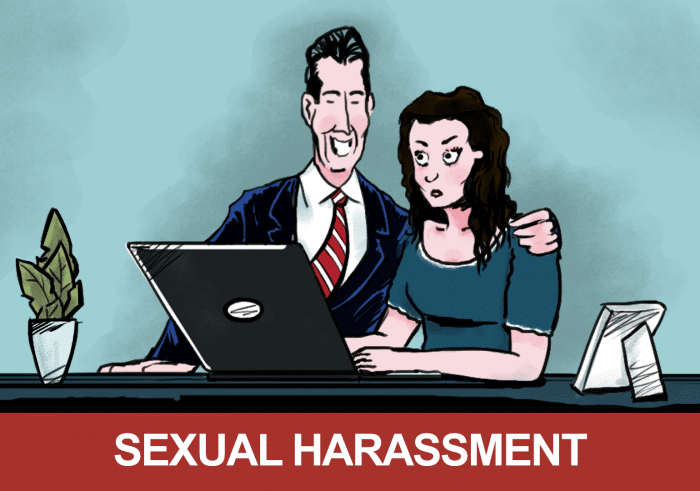Sexual harassment is a pervasive issue that transcends geographic boundaries, impacting individuals in workplaces, schools, and various other settings. In New York City, a global hub with a diverse population, the fight against sexual harassment takes on a particular significance. This article delves into the complexities of sexual harassment as a form of discrimination and explores how New York City, with its unique legal landscape and initiatives, combats this unlawful behavior. From defining sexual harassment to understanding the legal framework, reporting mechanisms, and the #MeToo movement’s impact, we’ll unravel the multifaceted dimensions of this critical issue.
I. Understanding Sexual Harassment
1.1 Defining Sexual Harassment
Sexual harassment is a form of discrimination that involves unwelcome sexual advances, requests for sexual favors, or other verbal or physical conduct of a sexual nature. It creates a hostile or intimidating environment for the victim, affecting their emotional well-being, job performance, and overall quality of life.
1.2 Types of Sexual Harassment
Sexual harassment can manifest in various ways, including quid pro quo harassment, where employment benefits are conditioned on sexual favors, and hostile work environment harassment, which involves pervasive offensive behavior that creates an intimidating workplace atmosphere.
II. Legal Framework
2.1 Title VII of the Civil Rights Act
Title VII of the Civil Rights Act of 1964 is a federal law that prohibits sexual harassment as a form of sex discrimination in the workplace. This legislation provides a basis for legal action against sexual harassment at the national level.
2.2 New York State Laws
New York State has its legal framework for addressing sexual harassment, including the New York Human Rights Law. The state laws provide additional protections and remedies for victims of sexual harassment.
2.3 Local Ordinances
New York City has local ordinances that further strengthen protections against sexual harassment. These ordinances extend the scope of anti-harassment measures within the city.
III. Reporting Mechanisms
3.1 Reporting Sexual Harassment
Victims of sexual harassment in New York City have various reporting mechanisms at their disposal. These include internal company procedures, contacting the New York State Division of Human Rights or the New York City Commission on Human Rights, or seeking legal counsel.
3.2 Anonymous Reporting
Many organizations in New York City offer anonymous reporting options, allowing victims to report sexual harassment without revealing their identity.
IV. Legal Protections
4.1 Remedies and Compensation
Legal protections for victims of sexual harassment in New York City include remedies and compensation for the harm they have endured. These can include monetary damages, reinstatement, and changes in workplace policies.
4.2 Whistleblower Protections
New York State provides whistleblower protections to employees who report sexual harassment. These protections safeguard individuals from retaliation by their employers.
V. Impact of the #MeToo Movement
5.1 The #MeToo Movement in New York City
The #MeToo movement, which gained momentum in 2017, has had a significant impact in New York City. It led to increased awareness, conversations, and legal changes regarding sexual harassment.
5.2 Changes in Reporting
The #MeToo movement encouraged more victims to come forward and report sexual harassment, shedding light on the prevalence of this issue.
VI. Preventing Sexual Harassment
6.1 Employer Responsibilities
Employers in New York City are obligated to take measures to prevent sexual harassment, including establishing clear policies, providing training, and creating reporting mechanisms.
6.2 Employee Training
Many organizations in New York City provide sexual harassment training to employees, educating them about what constitutes sexual harassment and how to prevent it.
VII. Challenges in Addressing Sexual Harassment
7.1 Barriers to Reporting
Victims of sexual harassment often face barriers to reporting, such as fear of retaliation, lack of awareness, or concerns about confidentiality.
7.2 Legal Challenges
Legal challenges in addressing sexual harassment include burdens of proof, statutes of limitations, and the need for comprehensive legislative reform.
VIII. Promoting Cultural Change
8.1 Promoting Gender Equality
Promoting gender equality is crucial to combating sexual harassment in New York City and beyond. Fostering a culture of respect and inclusivity is a collective effort.
8.2 Raising Awareness
Raising awareness about sexual harassment is an essential step in creating cultural change. This includes education, public campaigns, and open dialogue.
IX. Conclusion
Sexual harassment is discrimination and is illegal in New York City, but the fight against it is ongoing. Understanding the definition of sexual harassment, the legal framework, reporting mechanisms, and the impact of the #MeToo movement is crucial in addressing this pervasive issue. By promoting cultural change, raising awareness, and advocating for gender equality, New York City can continue its efforts to combat sexual harassment, ensuring a safer and more inclusive environment for all its residents and workers.

